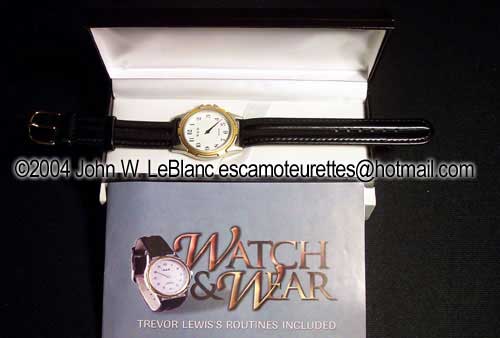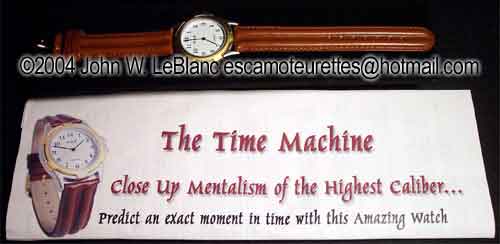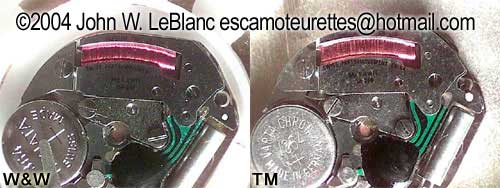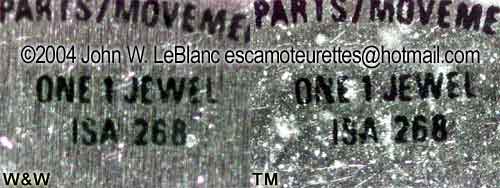You might have noticed that, on occasion, I mention the plague in magic called “knock-offs” — where one manufacturer takes another manufacturer’s item and duplicates it. I won’t spill precious digital ink going over the same territory; you can read some of my older blog entries for those sermons. Suffice it to say that I condemn knock-offs as unethical behavior and particularly egregious in this tiny world of magic and mentalism. It is not innovation to take someone else’s trick and duplicate it.
One of the apparent knock-offs I’ve mentioned is Magic Makers’ The Time Machine, which to my eye is a duplicate of Bazar de Magia’s Watch & Wear trick. Visually, they are nearly identical in both size, styling and coloring. But the real test for it being a duplicate required comparisons between the watches’ insides.
The purpose of this post is to lay out some observations I’ve made between both watches. Please read them over. Study the pictures. Then draw your own conclusions.
I already had The Time Machine, having purchased it at a favorable price a couple of years ago via an eBay auction before I’d become aware that it and Bazar de Magia’s Watch & Wear were being compared as identical twins. Since I didn’t have Watch & Wear, I contacted Martin at Bazar de Magia and asked if he’d be willing to send to me a piece for the purposes of comparison. He quickly agreed and a safely packaged Watch & Wear was on its way from Buenos Aires, Argentina to Casa LeBlanc.
My package from Bazar de Magia arrived late last week. I immediately walked it to my watch bench for a look.
Here is a picture of Bazar de Magia’s Watch & Wear as you receive it. It is packaged in a spring-closed watch box. It is accompanied by a nicely printed owners manual containing information on the watch itself, basic operation, and routines contributed by Ernesto Canki and Trever Lewis. There’s also a note to watch shops with instructions on replacing the watch battery without causing harm to the gimmick. Finally, there’s a numbered certificate spelling out the details of your one year warranty.

In comparison, Magic Makers’ The Time Machine arrives in a felt covered plastic sleeve. The instructions are printed on three separate 8-1/2 x 11 sheets of paper loosely folded together around the plastic watch sleeve. The instructions state, “Unlike its nearest competitor it was engineered from the ground up and manufactured using some of the finest components available.” You are warned about damaging the watch stem when replacing the battery, and given details of your 30 day warranty.

Watch & Wear sells on the street for about $160; The Time Machine can be picked up for around $80.
Let’s deal with the “engineered from the ground up” claim. Watch & Wear hit the market almost seven years ago. A couple of years later, The Time Machine was released. Here are both watch faces side by side:

To my mind, the remarkable similarity between these watches immediately called into question what Magic Makers means by “engineered from the ground up.”
The next step in comparison involved removing the watch case backs and viewing the watch movements.
There are hundreds of different quartz movements used in thousands of styles of watches manufactured each year. Quartz movements basically consist of circuitry that uses a crystal to establish a computer clock signal that’s fed to a tiny stepper motor, all powered by a small battery. Tuned properly, the stepper motor advances the watch gears in proper time.
Over the years quartz movements have gotten smaller to the point where an incredibly accurate watch movement would fit on the fingernail of your smallest finger.
In viewing the movements nestled in the watch cases of both watches, it became apparent they were identical. By that, I mean they were the same model movement manufactured by the same Asian factory: Precision Time Co., LTD in Shenzhen, a city in the Guangdong Province of China. The next two pictures bare that out. They are photos taken of the watch movements under a microscope at 10X:

These are pictures of the center of the movement, but at 60X:

So. What does “engineered from the ground up” actually mean? Certainly not the look of the watch. Certainly not the watch movement.
But the bigger question is this: does it matter to you?
Does it matter to you that one manufacturer produces prop that’s virtually identical to that of one that’s been on the market for years, while claiming to have designed it “from the ground up”?
As I’ve written before, there are effects, methods and tricks. They are not the same thing, although you will see many people refer to a trick as an effect. A card turning face up in a face down deck is an effect. A half-pass or Ultra Mental are methods. Invisible Deck is a trick.
The concept of predicting the hour and minute chosen by a spectator is an effect. Leslie Anderson’s watch trick (Magick #246) — which was the foundation for Danny Korem’s “Stull-ess Watch Stunner” (from The Lost Pages of Kabbala) among others — is just one way of many to create the effect you can with a Stull Watch, Perfect Time, Watch & Wear, and The Time Machine.
But this is not about duplicating an effect. It’s not about duplicating the method. It’s about blatantly duplicating a particular version of a trick used to create the effect, down to the same watch style, size and color.
I find such behavior detrimental to the world of magic, and I believe it’s unethical behavior. Production of such props is bad enough, but customers purchasing knock-offs says three things: first, you aren’t interested in recognizing and supporting the intellectual rights of magic inventors; second, you tell inventors their ideas aren’t worth respecting or protecting; and third — and this is the worst part — you reward knock-off manufacturers, which tells them they have a legitimate place in our little world of magic.
Is that what you believe?
Thanks for the in-depth look. Aside from the ethical problems, which I don’t mean to dismiss lightly, I also find it sad that the copy-cat could have introduced a different style of watch. This at least would have given them the guise of “providing choice” to the market. As it is, it’s simply a blatant copy with no possible rationalization.
I like your Blog very much. 10 Plus
Regards from France
Cornelius
Hello, Cornelius. Wow — that’s quite a compliment. Thanks!
This is a good comparison. I own W & W since 2001 and I am proud of it but I still find the battery replacement instruction lacking. I have a question. When the back of W & W watch is opened that’s what inside and the battery is pulled out and replaced as easily? I’ll leave that to the watch guys, but they are old you know. I dont want them screw*** the mechanism up. Thanks a mil, you may e-mail me if you want to or reply here for the benefit of all.
Thanks